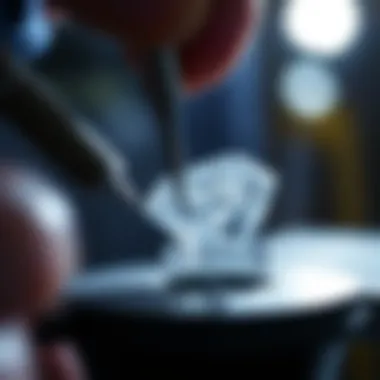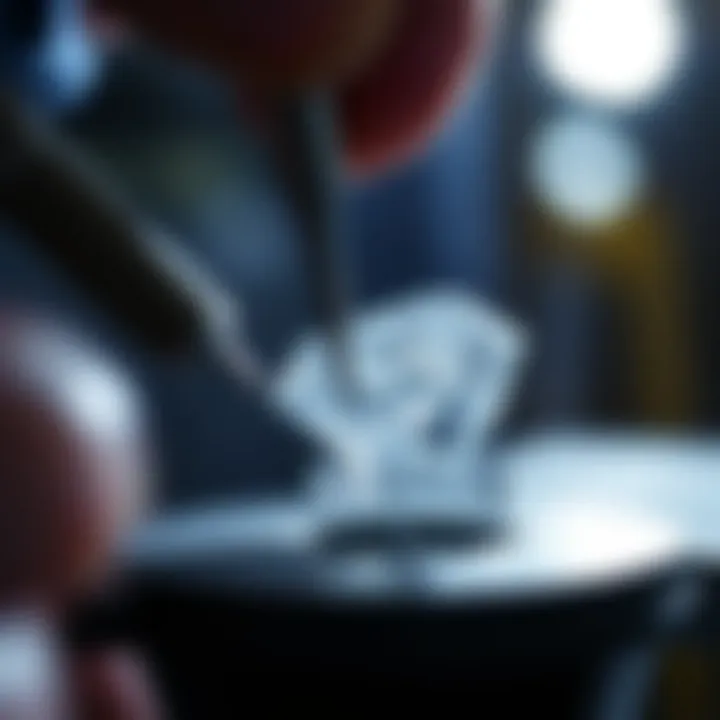Exploring the Diverse Applications of Diamonds


Intro
Diamonds are often pigeonholed as mere baubles adorning fingers and necks, a status symbol for the elite. However, tapping into their true worth unveils a tapestry of applications that stretch far and wide. This piece intends to peel back the layers of this multifaceted gem, revealing not only its shimmering allure but also its unparalleled utility across various industries. From the glare of industrial machinery to the subtle touch in medical instruments, diamonds play a role few could fathom, transcending the realms of luxury and entering the profound sectors of science and engineering.
The journey through this article will illuminate the key points surrounding diamonds’ diverse uses. It’s a guide that invites readers, especially those with a keen eye for rocks and fossils, to explore beyond the sparkle and understand the underlying significance of diamonds in both everyday and specialized applications. The old adage, ‘a diamond is forever,’ rings true, but not solely for romantic gestures; these gems have proven their durability and functionality across countless fields.
Let’s begin this exploration by grounding ourselves in the ancient history and origins of diamonds.
Intro to Diamonds
Diamonds are often perceived simply as luxurious gemstones, prized for their sparkly appeal. However, the reality is much more profound. They are not just adornments but hold significant importance across various industries. Understanding diamonds starts with recognizing their origins and the historical contexts in which they flourish. This article will set the stage to explore how diamonds transition from being mere status symbols to fundamental elements in technology, medicine, and beyond.
The Formation of Diamonds
Diamonds are formed under extreme pressure and temperature conditions deep within the Earth’s mantle, about 100 miles down. This natural process takes millions to billions of years, where carbon atoms bond in a crystal structure resulting in the hardest material known. It doesn’t stop there, though. Diamonds can be produced synthetically through methods like High Pressure High Temperature (HPHT) and Chemical Vapor Deposition (CVD). These synthetic options have grown in popularity, catering to industries requiring high-quality diamonds without the drawn-out timeline of natural formation.
"Diamonds are not just the hardest naturally occurring substances; they are also versatile and applicable in numerous high-tech and industrial domains."
Historical Context
Historically, diamonds have enchanted civilizations from ancient India, where they were first discovered, to the lavish courts of Europe. Through trade routes, these gemstones spread their allure. The significance of diamonds transcends mere wealth; they embody power, protection, and even divine properties in many cultures. Consider the Koh-i-Noor, a gem that has altered dynasties and politics owing to its rich history.
In the 20th century, the marketing genius of De Beers helped to cement diamonds as a symbol of love and commitment. Phrases like "A diamond is forever" transformed the landscape of jewelry and embedded these gems into romantic traditions. This historical journey illustrates the dual nature of diamonds: admired for their beauty and revered for their industrial capabilities.
Diamonds in Jewelry
The importance of diamonds in jewelry extends beyond their sparkling surface; they act as symbols that mark significant life events ranging from engagements to anniversaries. These cherished stones hold stories within their facets and have been intrinsically linked to human emotions and celebrations throughout history.
Cultural Significance
The cultural importance of diamonds cannot be overstated. From folklore to contemporary rituals, diamonds often symbolize fidelity, power, and prosperity. Historically, civilizations that appreciated these gems understood them to be more than just decorative stones. For instance, in ancient India, diamonds were thought to hold protective powers that could ward off evil spirits, while in Western cultures, they became a staple in engagement rings during the 19th century.
Additionally, different cultures encapsulate unique traditions surrounding diamond jewelry. For example, in various African traditions, specific diamond jewelry pieces are crafted and passed down through generations, signifying both heritage and wealth.
Some key points to highlight the cultural significance include:
- Symbol of Love: Widely recognized as the quintessential engagement ring stone, a diamond signifies commitment and partnership.
- Status Indicator: In various societies, diamond ownership often denotes social class and affluence, influencing personal and collective identity.
- Traditional Roles: Certain diamond-studded pieces are integral to marriage ceremonies in many cultures, embodying heritage and familial values.
Market Trends
The diamond market is a dynamic landscape reflecting cultural shifts, technological advancements, and consumer preferences. Recent trends show an increasing movement toward ethical sourcing and sustainability, driven by a change in consumer attitudes towards environmental impacts. Many buyers now prefer conflict-free diamonds, sparking a rise in sustainable jewelry brands that focus on transparent sourcing.
In terms of style and design, the market has seen a growing inclination toward unique, custom-cut diamonds over traditional shapes, increasing the landscape for creative expression in jewelry.
Some notable trends include:
- Lab-Grown Diamonds: The acceptance of lab-created diamonds is changing the landscape, providing a more accessible, but equally stunning, option.
- Vintage Resurgence: A rekindled interest in vintage and antique pieces highlights the significance of craftsmanship and historical artistry in today’s market.
- Online Sales Growth: The digital marketplace continues to expand, with more consumers opting for online purchases, which offers a wider variety without geographical constraints.


As diamonds find their place in modern society, their roles in jewelry dance between tradition and innovation, inviting collectors and enthusiasts to partake in a meaningful journey of aesthetic appreciation and cultural celebration.
Industrial Applications
Diamonds aren't merely for flaunting on engagement rings or as status symbols. In fact, their industrial applications provide a treasure trove of utility, making them a crucial part of modern engineering and technology. The unparalleled hardness and thermal conductivity of diamonds make them standout materials for a range of tasks. Understanding how diamonds fit into industrial processes not only showcases their practicality but also emphasizes their unique role in enhancing the performance and longevity of tools and machinery.
Cutting and Drilling
When it comes to cutting through materials, diamonds reign supreme. Their robustness allows for precise cuts in hard materials like concrete, metal, and stone. Diamond-tipped drills and saws are common in construction and mining industries, where efficiency translates into cost savings.
Because of their exceptional hardness, diamond drills allow builders and miners alike to work faster and cut neater, reducing the time and friction that could damage tools. This methodology can extend the lifespan of the equipment while ensuring a clean outcome—a win-win.
Notably, diamond drill bits are often utilized in oil drilling, a particularly harsh environment that demands both durability and efficiency. The investment in diamond tools often pays dividends in the long run, as the cost per cut can be lower than using conventional bits, due to reduced wear and tear.
Polishing and Grinding
Polishing and grinding are essential processes in manufacturing, where achieving a smooth finish can be the difference between a quality product and an outright failure. Diamonds are used in grinding wheels and polishing pads because they effectively abrade other materials. This allows various industries—not just jewelry—to attain ultra-smooth surfaces on metals, glass, ceramics, and a range of other materials.
The tiny diamond particles, suspended in a resin or metal bond, create grinding and polishing tools that are remarkably efficient and long-lasting. This results in less downtime, more production hours, and, ultimately, enhanced productivity. An added benefit is consistency; diamonds can maintain specific finishes across batches, thus guaranteeing quality standards.
Abrasives
Beyond cutting and polishing, diamonds also serve as one of the most effective abrasives. Their extreme hardness allows for effective material removal without drastically altering the shape or quality of the material being worked on. In fact, diamonds are used in various forms of abrasive products, from powders to wheels, utilized in fields ranging from automotive manufacturing to aerospace.
Diamonds help in achieving the desired precision in tasks like surface preparation, machining metals, and even in some dental equipment. By utilizing diamond abrasives, industries gain not only quality and consistency but also meet the demanding requirements for high-precision manufacturing.
In summary, diamonds hold a profound significance in industrial applications, from cutting and drilling to polishing and grinding. Their unparalleled properties enable improved efficiency, durability, and productivity across various sectors. As technology continues to advance, we can only anticipate further integration of this unique material into modern innovations.
"Diamonds have found their way into more than just jewelry; they are shaping the future of industry in remarkable ways."
For further reading, consider exploring sources such as Britannica and Wikipedia, which elaborate on the fundamental properties of diamonds and their various uses.
Technological Advancements
The realm of diamonds extends far beyond their glimmering allure in jewelry stores. Within technological advancements, diamonds play a pivotal role, showcasing their multifaceted nature. This section delves into the remarkable attributes of diamonds that make them indispensable in various cutting-edge applications. As researchers and industries continuously seek to enhance performance and efficiency, diamonds emerge as a favored material, pushing the boundaries of science and technology.
Semiconductor Applications
Diamonds are making waves in the semiconductor space, an area that thrives on efficiency and precision. Their electrical properties are unique. Unlike silicon, which has been the predominant material in semiconductor devices, diamonds can withstand much higher temperatures and effectively dissipate heat. This capability not only prevents overheating but also allows for faster processing speeds, a critical factor in today’s tech-heavy environment.
Moreover, diamonds possess a wide bandgap, enabling devices to operate at higher voltages and frequencies. This advancement is a boon for power electronics used in electric vehicles, renewable energy systems, and advanced computing. Companies are exploring high-performance diamond semiconductors to improve energy efficiency and reduce losses in power systems.
For instance, the recent developments in diamond field-effect transistors hold remarkable promise, potentially leading to breakthroughs in telecommunications and satellite technology. Notably, the implementation of diamond-based devices could revolutionize next-generation smartphones and wearables, making them faster and more energy-efficient.
"Diamonds are not just a girl's best friend; they are poised to become a cornerstone of futuristic technology—combining elegance with advanced performance."
Laser Technology
Another fascinating aspect of diamond applications lies within laser technology. Diamonds are heralded for their unparalleled endurance when used in laser optics and high-power laser applications. They operate effectively across a broad range of wavelengths and maintain their integrity over extended use, unlike many traditional materials that degrade or require frequent replacements.
The heat capacity of diamonds is impressive, allowing them to handle intense laser outputs without faltering. This makes diamonds ideal for creating high-energy lasers used in medical procedures, industrial cutting, and drilling applications. Imagine surgeries where precision is paramount; laser systems fitted with diamonds can minimize damage to surrounding tissues, vastly improving patient recovery times.


Furthermore, research is in progress to develop diamond lasers, which could fundamentally change devices used in telecommunications and data transmission. With light traveling faster in high-quality diamond lasers, we could witness phenomena such as quicker data transfers and accelerated internet speeds.
In summary, the surge of diamonds into the technological domain underscores their capacity to shape our future. Whether in semiconductors or laser technology, the potential for diamonds to enhance performance characteristics is substantial. As we continue to explore their characteristics, it becomes increasingly clear that diamonds are much more than just symbols of luxury—they are becoming pillars of innovation in modern technology.
Diamonds in Medicine
Diamonds, while often associated with luxury and adornment, wield significant potential within the medical field. Their unique physical properties make them invaluable in various applications, ranging from surgical instruments to diagnostic tools. An understanding of the multifaceted roles that diamonds play in medicine illuminates their relevance beyond traditional perceptions.
Innovations in Surgical Tools
In the world of surgery, precision is paramount. Diamonds, owing to their exceptional hardness, have found their way into advanced surgical tools. Surgical blades embedded with diamond particles offer sharper and more durable cutting edges compared to conventional steel tools. This sharpness is crucial for delicate procedures, allowing surgeons to make cleaner incisions with minimal trauma to surrounding tissues.
Beyond mere sharpness, diamond-coated tools, like scalpels, are resistant to wear, which translates into longer-lasting equipment. This could result in reduced overall costs for medical facilities, as they wouldn’t have to replace tools as often. Furthermore, the biocompatibility of diamonds means that there’s less risk of adverse reactions when these tools come in contact with human tissues, enhancing patient safety during operations.
"The integration of diamonds in surgical instruments marks a new era in precision healthcare."
With advancements in nanotechnology, there are even diamond blade prototypes that can conduct electrical signals. These tools could not only cut but also cauterize at the same time, leading to a streamlined surgical process. The future may well see further innovations that capitalize on diamonds' unique properties, potentially transforming surgical practices altogether.
Diagnostics and Imaging
Diamonds are carving out a niche as essential players in the field of diagnostics and imaging technologies. One of the most promising applications involves the use of synthetic diamonds in medical imaging. These diamonds can be engineered to detect flaws or signs of disease at a cellular level, providing a clearer picture of an individual’s health.
In particular, diamond-based sensors can measure biological activity through a technique called fluorescence. This method allows for non-invasive imaging, meaning doctors can monitor conditions without needing to resort to more intense procedures. For instance, diamond particles can be used in MRI technology to improve the quality of images, which might help in identifying tumors at earlier stages.
Some researchers have also started to explore the potential of diamonds in quantum sensing, which could revolutionize diagnostics. By harnessing the quantum properties of diamonds, practitioners can potentially achieve incredibly sensitive measurements, opening doors for earlier detection of various diseases.
To sum up, the role of diamonds in medicine is an intricate blend of innovation and practicality. From cutting-edge surgical tools to groundbreaking diagnostic techniques, their unique characteristics are driving advancements that could enhance medical practices and improve patient outcomes significantly. As this field evolves, one can only imagine the further applications that might emerge, underlining the importance of diamonds in transforming contemporary healthcare.
Environmental Impact and Sustainability
The conversation surrounding diamonds often pivots around their glimmering appeal and extravagant price tags. However, when we pivot to discuss their environmental impact and sustainability, the dialogue shifts toward a deeper understanding of how diamonds affect our planet. In an age where eco-consciousness is paramount, highlighting the sustainability aspect of diamonds becomes crucial, especially for those engaged in rock and fossil collecting who appreciate not just the image but the essence of what these gems represent.
Ethical Mining Practices
Ethical mining practices emerge as a core component in the discussion of diamond sustainability. Traditional diamond mining, frequently viewed through a lens of exploitation, raises concerns about ecological degradation and human rights violations. Consequently, the diamond industry faces scrutiny over the methods employed to extract these stones. It is no secret that "blood diamonds," sourced from conflict zones, have marred the reputation of diamond mining, leading to societal and environmental repercussions.
The solution to these issues lies in establishing transparent and responsible mining operations. For instance, many companies now prioritize sourcing diamonds from mines that adhere to global standards for ethical treatment of workers and restoration of mined lands. Companies such as De Beers have launched initiatives to ensure that their diamonds are conflict-free, while also investing in sustainable practices that promote biodiversity and environmental health in mining regions.
- Benefits of ethical mining:
- Preserves local ecosystems
- Fosters community development
- Reduces carbon footprint via responsible operations
When we extract diamonds ethically, not only do we contribute to the well-being of the workers involved, but we also help sustain the natural habitat in which these stones are found. In essence, an ethical mining practice is not merely a responsibility but a pathway to ensuring that future generations can also enjoy and study these remarkable natural formations.
Synthetic Diamonds
In the realm of sustainability, synthetic diamonds have emerged as a game-changer. Created in controlled environments, these diamonds mimic their natural counterparts while significantly reducing the associated environmental costs. Using methods such as High Pressure High Temperature (HPHT) and Chemical Vapor Deposition (CVD), synthetic diamonds can be produced with minimal environmental disturbances.


The advantages of synthetic diamonds are manifold:
- Resource Conservation: They require less land disturbance and water compared to traditional mining.
- Lower Carbon Emissions: The process of creating synthetic diamonds generates fewer emissions, aligning with a variety of global sustainability goals.
- Affordability: Typically, these diamonds are more wallet-friendly, making them accessible to a broader audience who may wish to invest in diamonds without carrying the traditional price tags.
Not only do they stand as an ethical alternative, but synthetic diamonds also offer a breadth of applications in industries beyond jewelry, such as electronics and medicinal technologies. The debate surrounding their authenticity often misses the bigger picture—these lab-grown beauties represent a step toward integrating luxury with sustainability, providing options that are both elegant and environmentally friendly.
The shift to synthetic diamonds is not just a trend; it's a potential revolution in how we perceive luxury materials in the context of our planet’s health.
In summary, as we navigate the complexities of diamonds within the spheres of environmental impact and sustainability, it becomes ever clearer that responsible practices—whether through ethical mining or embracing the potential of synthetic options—could reshape the diamond industry into a model for sustainable luxury. By valuing the earth alongside our admiration for these beautiful stones, the future can shine just as brightly.
Diamonds in Electronics
The role of diamonds in electronics is often overshadowed by more common materials like silicon and copper. However, the unique properties of diamonds make them exceptionally valuable in this field. Diamonds are renowned for their extraordinary thermal conductivity, electrical insulating capabilities, and resistance to radiation. These qualities allow diamonds to be employed in electronics that require reliable performance under challenging conditions. Whether in data processing or heat management systems, diamonds are emerging as essential materials that ensure efficiency and longevity in devices.
Heat Spreaders
In the fast-paced world of electronics, managing heat is a crucial challenge. Higher performance devices generate more heat, which can lead to overheating and eventual failure. Diamonds are uniquely suited for this task due to their impressive thermal conductivity, which is superior to that of metals such as copper and aluminum. This means that diamonds can dissipate heat more effectively, allowing components to operate within safer temperature ranges.
The integration of diamond heat spreaders into high-performance electronics provides numerous benefits:
- Efficiency: By enhancing heat dissipation, diamonds improve the efficiency of devices, reducing energy waste.
- Reliability: With better heat management, the lifespan of electronic components increases, decreasing the frequency of repairs or replacements.
- Miniaturization: The effective thermal management properties can allow for smaller, more compact designs in technology, which is beneficial in an era where space is at a premium.
However, using diamonds in heat spreader applications is not without its challenges. The cost of diamonds, particularly natural ones, can be prohibitively high. Nonetheless, advancements in synthetic diamonds are bringing costs down, making this technology more accessible. In high-end applications such as lasers and satellite systems, the benefits often justify the expense.
Optical Components
Diamonds also shine in the realm of optical components, taking advantage of their excellent transparency and hardness. They possess remarkable qualities that allow for superior performance in optical systems, such as lenses and windows. The ability of diamonds to transmit a wide spectrum of light makes them ideal for various applications, including high-powered lasers and advanced sensor technologies.
Some notable attributes of diamond-based optical components include:
- Durability: Diamonds can withstand extreme conditions without degrading, making them perfect for environments where other materials may fail.
- Refraction: The unique refraction properties of diamonds allow for the precise manipulation of light, enhancing imaging systems used in scientific and industrial applications.
- Broad Spectrum Transparency: Diamonds are transparent to ultraviolet light as well as the visible spectrum, enabling them to be used in specialized optical systems where other materials can’t perform adequately.
The challenges faced in utilizing diamonds for optical components often relate to production and fabrication. Cutting and polishing diamonds for precision optics can be complicated. Despite these obstacles, the ongoing research and technological advancements in synthetic diamond manufacturing are promising, paving the way for broader use of diamonds in cutting-edge optical technologies.
"Diamonds in electronics signify a leap forward, merging beauty with technological advancement."
In summary, diamonds present numerous advantages in electronics, from improving heat dissipation to enhancing optical performances. As technology continues to evolve, the utilization of diamonds may become standard practice in electronic devices, leading to innovations that could reshape various industries. The ongoing exploration of diamond applications reflects not only the natural beauty of diamonds but also their indispensable utility in modern technology.
Epilogue
Diamonds carry a weight that goes way beyond their shiny exteriors. Their multiple uses in various fields make them quite the unsung heroes in both everyday life and specialized arenas. In this article, we have taken a comprehensive look at how diamonds serve practical purposes—not just as objects of desire within the realm of jewelry, but also in industrial applications, technological advancements, and even in the medical field. This overview has uncovered the diverse roles that diamonds play, encouraging us to rethink their place in society.
The Future of Diamond Utilization
Looking ahead, the future of diamond utilization appears promising. As technology continues to evolve, the potential for diamonds seems to expand exponentially. Here are a few areas worth keeping an eye on:
- Advanced Electronics: With the race for faster processors, diamonds are being explored for their thermal conductivity, which could improve heat dissipation in microchips.
- Medical Innovations: The use of diamonds in medical tools is becoming more prevalent, particularly in the development of precision instruments for surgery and diagnostics. Their biocompatibility opens doors for exciting advancements.
- Sustainable Practices: As ethical mining becomes the norm, synthetic diamonds could become a gold standard, impacting both the environment and industry practices holistically.
Diamonds could be turning into key players in revolutionizing technology and improving existing processes. The boundaries of their utility seem to know no bounds, laying the groundwork for future developments and applications that are yet to be imagined.
Final Thoughts
In summation, diamonds shouldn't merely be viewed as a luxury but as multifaceted treasures that contribute to innovation and progress in myriad sectors. Their strength, durability, and unique properties render them exceptionally useful. As we continue to integrate diamonds into various applications, we cultivate an appreciation for their significance beyond embellishments. Understanding these dynamics not only enriches our comprehension of diamonds but empowers us to recognize their critical role in shaping the future.
The journey of diamonds from being simple rocks formed under pressure to indispensable tools in cutting-edge fields illustrates their transformative power and versatility. Hence, it’s essential for both collectors and enthusiasts to stay informed about the every-evolving landscape of diamond utilization.



